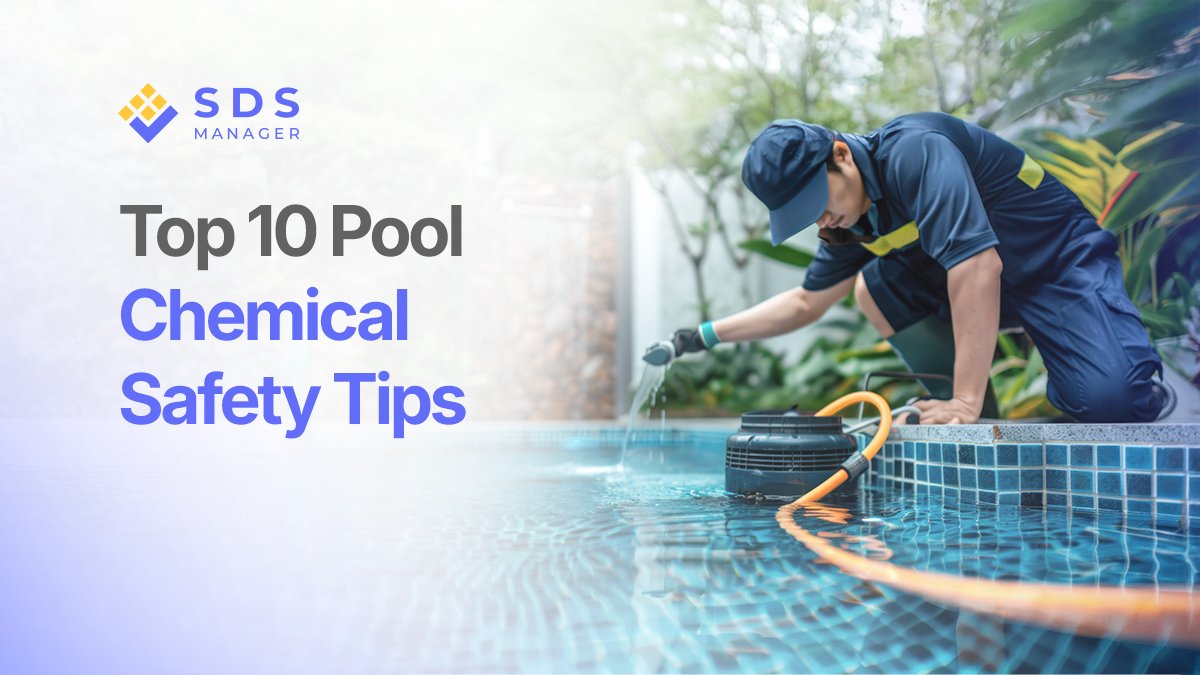

A safe pool starts in the storage room. When chemicals are handled right, water stays clean, equipment lasts longer, and people stay healthy.
This guide introduces easy-to-follow pool chemical safety tips, including how to store, handle, dose, and respond to spills, so your site runs smoothly and safely.
Whether you manage a public facility or service backyard pools, the steps below are simple, repeatable, and aligned with public health guidance.
The Top 10 Pool Chemical Safety Tips
Common pool chemicals and why balance matters
Most pools rely on:
- a sanitizer (chlorine or bromine)
- pH control chemicals
- alkalinity increasers
- a stabilizer (cyanuric acid)
- algaecides (as needed)
Getting your pool’s chemical balance wrong can lead to serious problems.
Mixing incompatible chemicals can cause skin irritation, create toxic gas, or even start a fire. Too much stabilizer can slow down the disinfection process, leaving your pool unclean.
Excessive chlorine while people are swimming can be hazardous and may require the pool to be closed. Always keep your chemical levels within the safe, recommended range. Be sure to follow the product labels and never mix different chemicals.
With that foundation, here are the top 10 pool chemical safety tips:
1. Store cool, dry, and below 95°F/35°C
Keep out of direct sun, control humidity, and protect products from getting wet. Follow the manufacturer’s storage instructions.
2. Separate incompatible chemicals
Keep chlorine products away from acids and store each in original, labeled, secondary containers. Use secondary containment or separate rooms when space is tight.
3. Ventilate and secure the pump room
Isolate the air-handling system from the rest of the building, provide good ventilation, and keep the room locked to prevent unauthorised access.
4. Use PPE every time
Gloves and eye protection are the minimum required PPE to prevent contact with chemicals that are irritant or corrosive. Add respiratory protection if dust or strong fumes are possible. Keep backup PPE handy just outside storage areas.
5. Dose the right way
Feed chlorine, bromine, and acids through the right feeders. Close the venue to swimmers if recirculation is off or during service. Restart systems and run at least 5 minutes before reopening when water meets standards.
6. Never mix chemicals or “top off” containers
Mixing (even different chlorine types) or introducing acid into chlorine streams can trigger toxic gas or heat. Improper mixing, wetting, or self-reaction can lead to fires or vapour releases.
7. Add chemicals to water, never water to chemicals
If the label calls for pre-dissolving, always pour the chemical into the water, slowly, to avoid violent reactions and splashes.
8. Be spill-ready
Keep a spill kit with dedicated, dry tools for dry products. Follow your plan, use SDS guidance, and dispose of waste per local hazardous waste rules or manufacturer instructions.
9. Maintain equipment and interlocks
Add alarms for pump shutdown and devices that stop chemical feed on no-/low-flow. Inspect tubing, clamps, and valves on a schedule. Document every fix.
10. Track use and communicate
Keep logs of what was added, when, and by whom. Quick team huddles before dosing prevent errors and keep everyone aligned.
Before You Start
Know your SDS and labels
Keep Safety Data Sheets (SDS) and product labels where you store and use chemicals. These provide information on hazards, PPE, first-aid, storage temperature, and spill response steps. Make sure every handler has quick access to them, including from outside the pump room, and ensure containers for storage have proper secondary container labels.
Train and post simple rules
Everyone who works with chemicals should be trained. Post a one-page rule sheet in the storage area and pump room for fill-ins and new hires.
Have an emergency plan
Include spill cleanup, evacuation, who calls 111, and key phone numbers. Keep one copy just outside the pump room and another at a remote location. Practice with local responders.
Final Thoughts
Pool chemical incidents are a real risk. New Zealand’s National Poisons Centre answers about 25,000 calls each year across exposures, and many are safely managed with expert advice, which helps reduce pressure on emergency care.
That's why a strong safety plan is so important. Following our chemical safety tips and your local aquatic health codes is the best way to prevent accidents. This practice keeps swimmers safe from germs, protects your staff and equipment, and helps you avoid costly shutdowns.
FAQs
How far apart should chlorine and acids be stored?
Store them in separate, dedicated areas or rooms; use secondary containment if space is tight, and keep everything in original, labelled containers.
What PPE is non-negotiable?
Gloves and eye protection at minimum; add respiratory protection if dusts or fumes are possible. Keep spare PPE outside storage rooms.
Can I dose while swimmers are in the water?
No. Close the venue when recirculation is off or during service, then restart and run systems at least 5 minutes before reopening once water meets standards.
Why “add chemical to water,” not water to chemical?
Adding water to certain chemicals can cause violent reactions. If pre-dissolving is required, add the chemical to water, slowly, per the label.
Do small facilities really need a written emergency plan?
Yes. A simple plan with roles, evacuation, and spill steps prevents panic and speeds response. Keep copies near and away from the pump room.